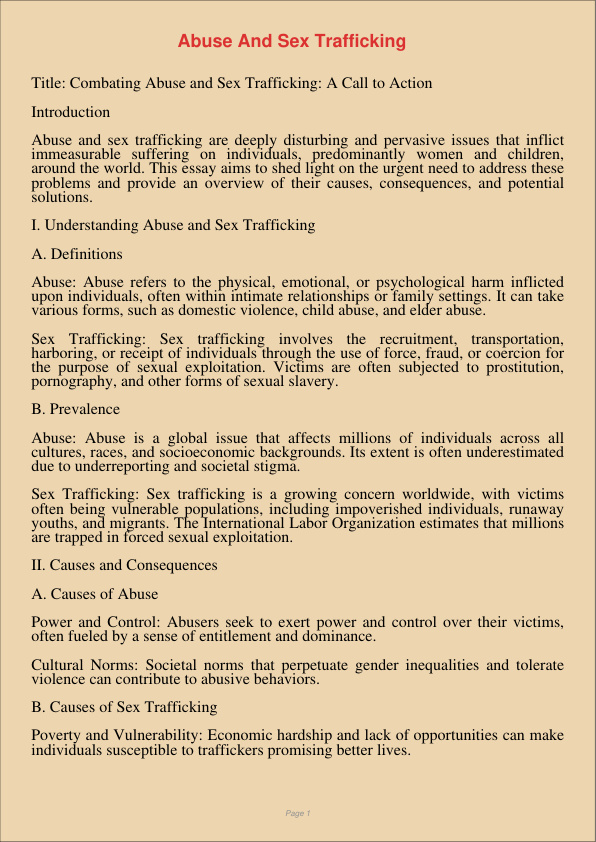Abuse And Sex Trafficking
Jan 8, 2024
sex trafficking
abuse
Religion and Theology
Geography

Title: Combating Abuse and Sex Trafficking: A Call to Action
Introduction
Abuse and sex trafficking are deeply disturbing and pervasive issues that inflict immeasurable suffering on individuals, predominantly women and children, around the world. This essay aims to shed light on the urgent need to address these problems and provide an overview of their causes, consequences, and potential solutions.
I. Understanding Abuse and Sex Trafficking
A. Definitions
Abuse: Abuse refers to the physical, emotional, or psychological harm inflicted upon individuals, often within intimate relationships or family settings. It can take various forms, such as domestic violence, child abuse, and elder abuse.
Sex Trafficking: Sex trafficking involves the recruitment, transportation, harboring, or receipt of individuals through the use of force, fraud, or coercion for the purpose of sexual exploitation. Victims are often subjected to prostitution, pornography, and other forms of sexual slavery.
B. Prevalence
Abuse: Abuse is a global issue that affects millions of individuals across all cultures, races, and socioeconomic backgrounds. Its extent is often underestimated due to underreporting and societal stigma.
Sex Trafficking: Sex trafficking is a growing concern worldwide, with victims often being vulnerable populations, including impoverished individuals, runaway youths, and migrants. The International Labor Organization estimates that millions are trapped in forced sexual exploitation.
II. Causes and Consequences
A. Causes of Abuse
Power and Control: Abusers seek to exert power and control over their victims, often fueled by a sense of entitlement and dominance.
Cultural Norms: Societal norms that perpetuate gender inequalities and tolerate violence can contribute to abusive behaviors.
B. Causes of Sex Trafficking
Poverty and Vulnerability: Economic hardship and lack of opportunities can make individuals susceptible to traffickers promising better lives.
Demand for Commercial Sex: The demand for commercial sex fuels the sex trafficking industry, making it a profitable criminal enterprise.
C. Consequences
Physical and Emotional Trauma: Abuse and sex trafficking survivors suffer from physical injuries, sexually transmitted infections, and long-lasting psychological trauma.
Loss of Dignity and Freedom: Victims of sex trafficking lose their autonomy and human rights, living in deplorable conditions.
III. Combating Abuse and Sex Trafficking
A. Prevention
Educational Programs: Implement educational programs that raise awareness about the signs of abuse, promote healthy relationships, and teach consent from an early age.
Economic Empowerment: Support initiatives that provide economic opportunities and job training to vulnerable populations, reducing their susceptibility to trafficking.
B. Legal and Judicial Measures
Strengthening Laws: Enforce and strengthen laws that criminalize abuse and sex trafficking, while also holding perpetrators accountable.
Victim Support: Ensure that victims have access to legal assistance, counseling, and safe shelters.
C. International Cooperation
Trafficking Deterrence: Promote international collaboration to deter sex trafficking and prosecute traffickers across borders.
Awareness Campaigns: Launch global awareness campaigns to educate people about the consequences of the sex trafficking industry and the role they can play in preventing it.
Conclusion
Abuse and sex trafficking are abhorrent violations of human rights that demand immediate attention and action. By addressing the root causes, enforcing legal measures, and promoting international cooperation, we can work toward a world where individuals are free from violence and exploitation. It is not only a moral imperative but also a societal obligation to protect and empower those who have been affected by these heinous crimes. Through collective efforts, we can create a future where abuse and sex trafficking are relegated to the annals of history.